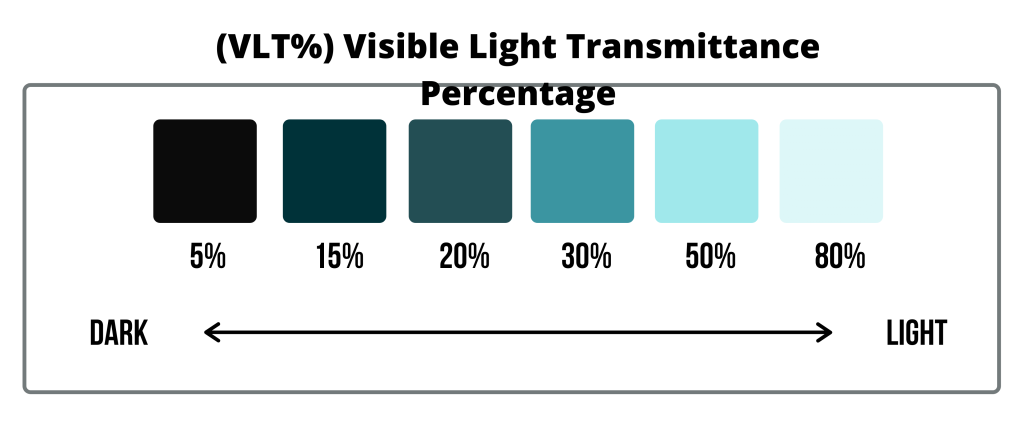The car window tinting laws in Arizona were enacted in the early 90’s. At TINT 360 in Phoenix we want car owners to be educated and understand the car legal window tint laws in Arizona before they make a final decision on their car window tinting shade. State of Arizona, window tinting laws were enacted in 1994. These AZ tint laws regulate how dark and reflective your car tint can be, but also specify other rules and regulations you must follow.
- Windshield Tinting: Arizona laws permit non-reflective tint along the top of the windshield, above the manufacturer’s AS-1 line.
- Front Side Windows Tinting: Tinting must allow more than 33% of light into the vehicle.
- Back Side and Rear Window Tinting: Any level of darkness can be used.
- Tint Reflection: The law does not permit metallic or mirrored appearance on the front and back side windows.
- Tint Colors: There are no tint color restrictions in Arizona.
Always remember, regulations can change, so before you decide on window tinting, please verify the information with your local law enforcement agency or check the official Arizona State Legislature website for the most current regulations. At TINT 360, we are committed to keeping up with these AZ tint laws and ensuring that our services align with them.
Arizona law states the amount and manner of window tinting a motor vehicle may have to be lawfully operated in this state. It is a violation of law to operate a vehicle that does not meet the window tinting requirements.
What are Arizona’s Car Window Tinting Requirements?
The law describes window tint in terms of darkness and reflectivity. It also refers to visible light transmission (VLT), or the percentage of light the tint allows into the vehicle. In Arizona, the law restricts what tint percentages of VLT is AZ legal tint according to different windows and vehicles. Arizona Revised Statute 28-959.01 lays out the rules a driver must follow if tinting his or her vehicle if it is a sedan, SUV or van.
- Front side windows must have a VLT of more than 33%.
- Back side windows and rear windows can be any darkness.
- If the back windshield has tint, the law requires dual side mirrors.
- Front and back side windows must not be more than 35% reflective (plus or minus 3% or less).
- The front windshield may only have non reflective tint, above the AS-1 line.
Colored or Reflective Car Tint Shades
It is against the law to use amber or red tint colors in Arizona. Only with a valid medical exemption may someone use a special type of tint, such as a different color or darker grade. Vehicle owners do not need stickers to identify AZ legal tint. Since some room for interpretation exists with the state’s window tint laws, separate police officers may enforce them differently. Additionally, Arizona allows medical exemptions for special tint in some cases.
Should a police officer stop you on the road for dark tinting, they have the right to issue you a citation after using a tint meter to determine if you’ve broken the law.
Specific questions should be directed to your local law enforcement agency.
Can you have limo tint on your car in AZ?
Limo tint is the darkest grade of tint available. In most places, a limo tint is 5% VLT, meaning it only allows 5% visible light transmission into the vehicle. It is illegal to use limo tint on the front side windows and the windshield of a sedan, SUV or van in Arizona. These windows must have tint with more than 33% VLT. A driver could, however, use limo tint on the rear side windows and the back windshield, if desired. Although technically a driver can use any tint darkness on the back and back side windows, if an officer believes the tint is dark enough to obstruct the driver’s view, the officer could still issue a ticket.
Window Tint Medical Exemption
There are some exceptions to the Arizona window tinting laws that are available to drivers who suffer from medical conditions such as sun skin disorders that they must be shielded from the direct rays of the sun at all times. If you are required for medical reasons to be protected from the sun and harmful UV Ray exposure, you may receive an exemption from the window tinting requirements. The exemption is granted for any vehicle you own as well as other vehicles in which you are a regular passenger.
To apply for the window tinting levels exemption, complete an Application for window tint Medical Exemption Here.
Form #40-1511, certified by a medical provider. The application will be forwarded to the Medical Review Program.
Ready to Get Started?





